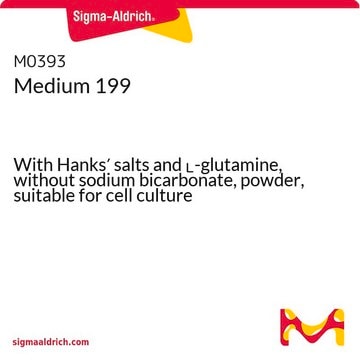T4674
Trypsin solution from porcine pancreas
sterile-filtered, BioReagent, suitable for cell culture, 25 g porcine trypsin per liter in Hanks′ Balanced Salt Solution with phenol red
Sign Into View Organizational & Contract Pricing
All Photos(1)
About This Item
Recommended Products
biological source
Porcine pancreas
sterility
sterile-filtered
product line
BioReagent
form
solution
mol wt
23.4 kDa
technique(s)
cell culture | mammalian: suitable
impurities
Porcine parvovirus, none detected (9 CFR)
pH
7.6
shipped in
dry ice
storage temp.
−20°C
Looking for similar products? Visit Product Comparison Guide
Application
For trypsin digestion of peptides, use a ratio of about 1:100 to 1:20 for trypsin:peptide. The typical use for this product is in removing adherent cells from a culture surface. The concentration of trypsin necessary to dislodge cells from their substrate is dependent primarily on the cell type and the age of the culture. Trypsins have also been used for the re-suspension of cells during cell culture, in proteomics research for digestion of proteins and in various in-gel digestions. Additional applications include assessing crystallization by membrane-based techniques and in a study to determine that protein folding rates and yields can be limited by the presence of kinetic traps.
Biochem/physiol Actions
Trypsin cleaves peptides on the C-terminal side of lysine and arginine residues. The rate of hydrolysis of this reaction is slowed if an acidic residue is on either side of the cleavage site and hydrolysis is stopped if a proline residue is on the carboxyl side of the cleavage site. The optimal pH for trypsin activity is 7-9. Trypsin can also act to cleave ester and amide linkages of synthetic derivatives of amino acids. EDTA is added to trypsin solutions as a chelating agent that neutralizes calcium and magnesium ions that obscure the peptide bonds on which trypsin acts. Removing these ions increases the enzymatic activity.
Serine protease inhibitors, including DFP, TLCK, APMSF, AEBSEF, and aprotinin, amongst others, will inhibit Trypsin.
Serine protease inhibitors, including DFP, TLCK, APMSF, AEBSEF, and aprotinin, amongst others, will inhibit Trypsin.
Caution
This product should be stored frozen at -20°C.
Unit Definition
One BAEE unit will produce a A253 of 0.001 per minute at pH 7.6 at 25°C using BAEE as a substrate.
Preparation Note
This is a 25 g/L porcine trypsin solution in Hank′s Balanced Salt Solution with phenol red.
Signal Word
Warning
Hazard Statements
Precautionary Statements
Hazard Classifications
Skin Sens. 1
Storage Class Code
10 - Combustible liquids
WGK
WGK 3
Flash Point(F)
Not applicable
Flash Point(C)
Not applicable
Certificates of Analysis (COA)
Search for Certificates of Analysis (COA) by entering the products Lot/Batch Number. Lot and Batch Numbers can be found on a product’s label following the words ‘Lot’ or ‘Batch’.
Already Own This Product?
Find documentation for the products that you have recently purchased in the Document Library.
Customers Also Viewed
Ivana Klun et al.
Parasites & vectors, 10(1), 167-167 (2017-04-06)
Consumption of undercooked or insufficiently cured meat is a major risk factor for human infection with Toxoplasma gondii. Although horsemeat is typically consumed rare or undercooked, information on the risk of T. gondii from infected horse meat to humans is
Feriel Yekkour et al.
Veterinary parasitology, 239, 31-36 (2017-05-13)
Toxoplasmosis is a parasitic disease with worldwide distribution and a major public health problem. In Algeria, no data are currently available about genotypes of Toxoplasma gondii isolated from animals or humans. The present study assesses for the first time the
Mian Zhang et al.
Journal of bone and mineral research : the official journal of the American Society for Bone and Mineral Research, 34(4), 726-738 (2018-11-30)
Traumatic joint injuries produce osteoarthritic cartilage manifesting accelerated chondrocyte terminal differentiation and matrix degradation via unknown cellular and molecular mechanisms. Here we report the ability of biomechanical stress to increase expression of the calcium-sensing receptor (CaSR), a pivotal driver of
Miguel Chenlo et al.
EBioMedicine, 43, 537-552 (2019-04-13)
Acromegaly is produced by excess growth hormone secreted by a pituitary adenoma of somatotroph cells (ACRO). First-line therapy, surgery and adjuvant therapy with somatostatin analogs, fails in 25% of patients. There is no predictive factor of resistance to therapy. New
Benoît X E Desbiolles et al.
Microsystems & nanoengineering, 6, 67-67 (2021-09-28)
Volcano-shaped microelectrodes (nanovolcanoes) functionalized with nanopatterned self-assembled monolayers have recently been demonstrated to report cardiomyocyte action potentials after gaining spontaneous intracellular access. These nanovolcanoes exhibit recording characteristics similar to those of state-of-the-art micro-nanoelectrode arrays that use electroporation as an insertion
Our team of scientists has experience in all areas of research including Life Science, Material Science, Chemical Synthesis, Chromatography, Analytical and many others.
Contact Technical Service









